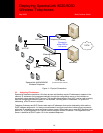
Deploying SpectraLink 8020/8030
Wireless Telephones
May 2009 Best Practices Guide
2.3.2 Push-to-Talk Multicasting Considerations
SpectraLink i640 handsets provide push-to-talk (PTT) functionality using the Polycom-proprietary
SpectraLink Radio Protocol (SRP) ADPCM encoding. Because the PTT mode uses IP multicasting, all
APs on the subnet will transmit a PTT broadcast. This can be limited to only the APs that are handling
one or more PTT-enabled handsets by enabling the Internet Group Management Protocol (IGMP) on the
wired infrastructure network.
When i640 handsets are deployed on a network with newer versions of SpectraLink handsets, some
interoperability considerations must be observed. The newer SpectraLink 8030 handsets have 24 PTT
channels plus one priority channel available. SpectraLink i640 handsets have eight PTT channels with no
priority channel. When PTT is activated on a network using a mix of handset versions, only the eight
common channels will be available for the i640 handsets.
2.3.3 Telephone Usage
When the handset is used with traditional PBXs through a Telephony Gateway, the PBX interface will
assemble audio, packetize it, and release these packets at a preset interval. The PBX release interval is
generally 20ms or 30ms. The SVP Server will receive these audio packets and release them to the
network for delivery to the handset every 30ms.
With a PBX release interval of 20ms, packets delivered to the handset by the SVP Server will have one
audio payload followed by a packet with two audio payloads. This pattern, one audio payload then two
audio payloads, will continue during the call. With a PBX release interval of 30ms, packets sent to the
handset will have one audio payload each. In rare occasions, a PBX may use a 40ms release interval.
With this audio payload release interval, packets delivered to the wireless telephone will have one large
audio payload or no audio payload per packet sent to the handset. The no audio payload packets and
long time between audio (two SVP packets – 60ms) payload aggravates any weakness (multi-path, retry
packets, etc.) in the WLAN and will cause poor audio. Therefore, whenever possible the PBX should be
configured to use release intervals of 30ms or 20ms.
Because data rate and packet rates are constant with voice applications, wireless telephone calls may be
modeled in a manner very similar to circuit-switched calls. Telephone users (whether wired or wireless)
generally tend to make calls at random times and of random durations. Because of this, mathematical
models can be applied to calculate the probability of calls being blocked based on the number of call
resources available.
Telephone usage is measured in units of Erlangs. One Erlang is equivalent to the traffic generated by a
single telephone call in continuous use. A typical office telephone user will generate 0.10 to 0.15 Erlangs
of usage during normal work hours, which equates to six to nine minutes on the telephone during an
average one-hour period. Heavy telephone users may generate 0.20 to 0.30 Erlangs, or an average of 12
to 18 minutes of phone usage in an hour. Note that traffic analysis is based on the aggregate traffic for all
users, so users with higher or lower usage are included in these averages.
The traffic engineering decisions are a tradeoff between additional call resources and an increased
probability of call blocking. Call blocking is the failure of calls due to an insufficient number of call
resources being available. Typical systems are designed to a blocking level (or grade of service) of 0.5
percent to two percent at the busiest times. Traffic model equations use the aggregate traffic load,
number of users and number of call resources to determine the blocking probability. The blocking
probability can also be used along with the aggregate traffic load to determine the number of call
resources required. Traffic model equations and calculators are available at www.erlang.com.
Consider a system with APs that can support six active telephone calls. If a blocking probability of one
percent or less is desired, each AP can support approximately 13 moderate wireless telephones users. If
13
©2009 Polycom, Inc. All rights reserved.
Polycom and the Polycom logo are registered trademarks of Polycom, Inc. All other trademarks are the property of Polycom, Inc. or their respective companies.


















